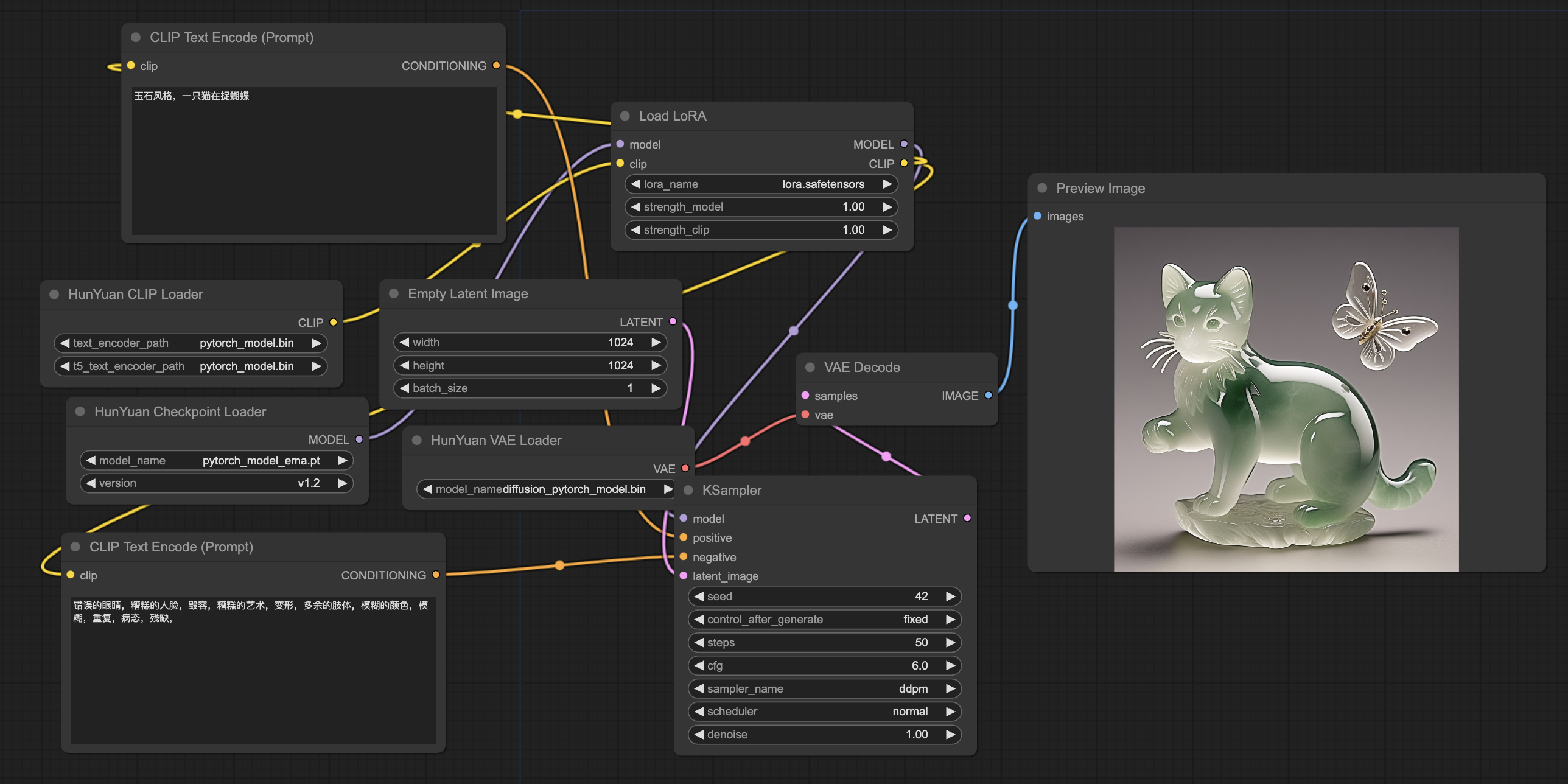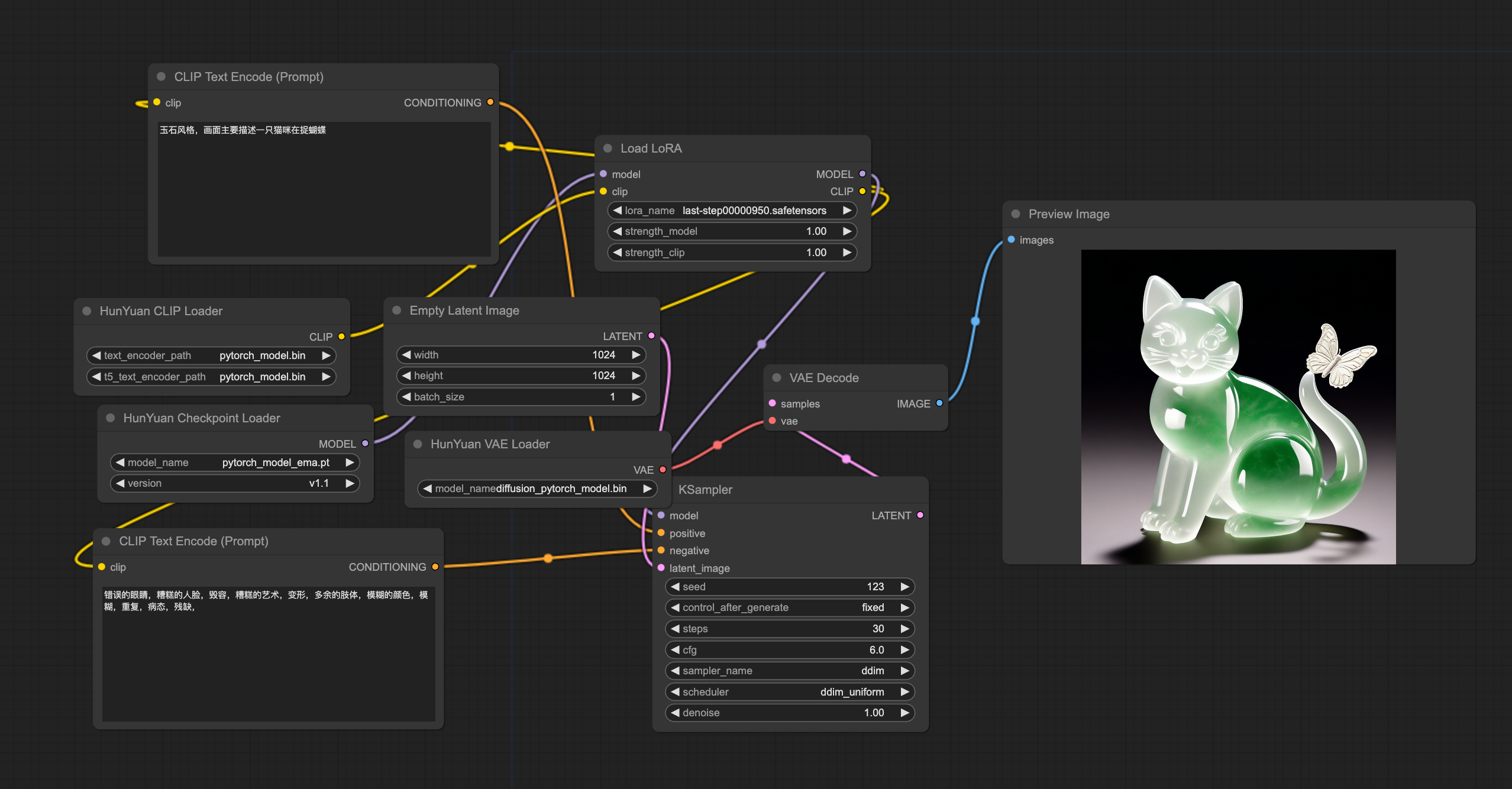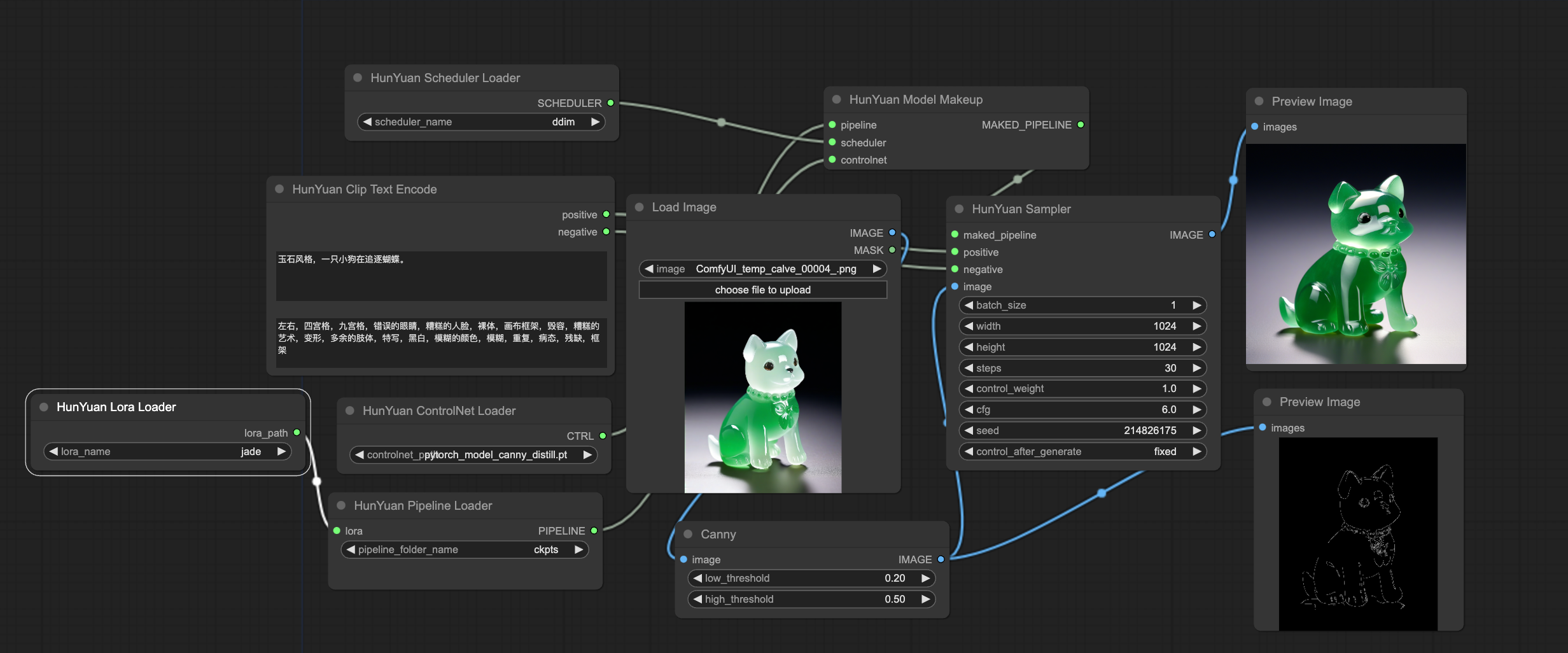The ComfyUI code is under review in the official repository. Meanwhile, a temporary version is available below for immediate community use. We welcome users to try our workflow and appreciate any inquiries or suggestions.
- Support two workflows: Standard ComfyUI and Diffusers Wrapper, with the former being recommended.
- Support HunyuanDiT-v1.1 and v1.2.
- Support module, lora and clip lora models trained by Kohya.
- Support module, lora models trained by HunyunDiT official training scripts.
- ControlNet is coming soon.
- Official ComfyUI Environment Setup
# Please use python 3.10 version with cuda 11.7
conda create --name comfyui-hydit python=3.10
conda activate comfyui-hydit
# Download comfyui code
git clone https://github.com/comfyanonymous/ComfyUI.git
cd ${ComfyUI}
git reset --hard 90389b3b8a69c08c3ed0bcc9d87a92246578a8e3
# Install torch, torchvision, torchaudio
pip install torch==2.0.1 torchvision==0.15.2 torchaudio==2.0.2 --index-url https://download.pytorch.org/whl/cu117 --default-timeout=100 future
# Install Comfyui essential python package
pip install -r requirements.txt- HunyuanDiT Environment Setup in ComfyUI
# Move to the ComfyUI custom_nodes folder and copy comfyui-hydit folder from HunyuanDiT Repo.
cd ${ComfyUI}/custom_nodes
git clone https://github.com/Tencent/HunyuanDiT.git
cp -r HunyuanDiT/comfyui-hydit ./
rm -rf HunyuanDiT
cd ${ComfyUI}/custom_nodes/comfyui-hydit
# Install some essential python Package.
pip install -r requirements.txt- (Optional) Deployment on Windows environment
cd ${ComfyUI}/custom_nodes
git clone https://github.com/Tencent/HunyuanDiT.git
xcopy /E /I HunyuanDiT\comfyui-hydit comfyui-hydit
rmdir /S /Q HunyuanDiT
cd ${ComfyUI}/custom_nodes/comfyui-hydit
# Install some essential python Package.
pip install -r requirements.txt- Running ComfyUI successfully
# Go to ComfyUI main folder
cd ${ComfyUI}
# Run the ComfyUI Lauch command
python main.py --listen --port 80-
Preparing Model Weights
Download the file to the specified folder using the command below. For additional download links, visit doc.
# (Optional) download pretrain-weight huggingface-cli download Tencent-Hunyuan/HunyuanDiT-v1.2 --local-dir ${HunyuanDiT}/ckpts # clip ln -s ${HunyuanDiT}/ckpts/t2i/clip_text_encoder/pytorch_model.bin ${ComfyUI}/models/clip/pytorch_model.bin # mt5 mkdir ${ComfyUI}/models/t5 ln -s ${HunyuanDiT}/ckpts/t2i/mt5/pytorch_model.bin ${ComfyUI}/models/t5/pytorch_model.bin # vae ln -s ${HunyuanDiT}/ckpts/t2i/sdxl-vae-fp16-fix/diffusion_pytorch_model.bin ${ComfyUI}/models/vae/diffusion_pytorch_model.bin # base model huggingface-cli download Tencent-Hunyuan/Distillation-v1.2 pytorch_model_distill.pt --local-dir ${ComfyUI}/models/checkpoints/
Put module weights trained through Kohya or the official script in
${ComfyUI}/models/checkpoints/to switch model weights in ComfyUI. -
Preparing LoRa Weights
# Put LoRa weights trained by Kohya in ComfyUI/models/loras cp ${HunyuanDiT}/kohya_ss/outputs/last-step{xxxx}.safetensors ${ComfyUI}/models/loras # (Optional) Put LoRa weights trained by official scripts in ComfyUI/models/loras python custom_nodes/comfyui-hydit/convert_hunyuan_to_comfyui_lora.py \ --lora_path ${HunyuanDiT}/log_EXP/001-lora_porcelain_ema_rank64/checkpoints/0000100.pt/adapter_model.safetensors \ --save_lora_path ${ComfyUI}/models/loras/adapter_model_convert.safetensors # update the `lora.py` file cp ${ComfyUI}/custom_nodes/comfyui-hydit/lora.py ${ComfyUI}/comfy/lora.py
-
Preparing Model Weights
python -m pip install "huggingface_hub[cli]" mkdir models/hunyuan huggingface-cli download Tencent-Hunyuan/HunyuanDiT-v1.2 --local-dir ./models/hunyuan/ckpts huggingface-cli download Tencent-Hunyuan/HunyuanDiT-v1.2 t2i/model/pytorch_model_ema.pt --local-dir ./models/hunyuan/ckpts/t2i/model -
Preparing LoRa Weights
# Put LoRa weights trained by Kohya in ComfyUI/models/loras cp ${HunyuanDiT}/kohya_ss/outputs/adapter_model.safetensors ${ComfyUI}/models/loras # (Optional) Put LoRa weights trained by official scripts in ComfyUI/models/loras # The PEFT diffuser format needs to be converted into the standard ComfyUI format python custom_nodes/comfyui-hydit/convert_hunyuan_to_comfyui_lora.py \ --lora_path ${HunyuanDiT}/log_EXP/001-lora_porcelain_ema_rank64/checkpoints/0000100.pt/adapter_model.safetensors \ --save_lora_path ${ComfyUI}/models/loras/adapter_model_convert.safetensors # update the `lora.py` file cp ${ComfyUI}/custom_nodes/comfyui-hydit/lora.py ${ComfyUI}/comfy/lora.py
Below I'm trying to document all the nodes, thanks for some good work[1][2].
- Loads the full stack of models needed for HunYuanDiT.
- pipeline_folder_name is the official weight folder path for hunyuan dit including clip_text_encoder, model, mt5, sdxl-vae-fp16-fix and tokenizer.
- lora optional to load lora weight.
- Loads the base model for HunYuanDiT in ksampler backend.
- model_name is the weight list of comfyui checkpoint folder.
- version two option, v1.1 and v1.2.
- Loads the clip and mt5 model for HunYuanDiT in ksampler backend.
- text_encoder_path is the weight list of comfyui clip model folder.
- t5_text_encoder_path is the weight list of comfyui t5 model folder.
- Loads the vae model for HunYuanDiT in ksampler backend.
- model_name is the weight list of comfyui vae model folder.
- Loads the scheduler algorithm for HunYuanDiT.
- Input is the algorithm name including ddpm, ddim and dpmms.
- Output is the instance of diffusers.schedulers.
- Assemble the models and scheduler module.
- Input is the instance of StableDiffusionPipeline and diffusers.schedulers.
- Output is the updated instance of StableDiffusionPipeline.
- Assemble the models and scheduler module.
- Input is the string of positive and negative prompts.
- Output is the converted string for model.
- Similar with KSampler in ComfyUI.
- Input is the instance of StableDiffusionPipeline and some hyper-parameters for sampling.
- Output is the generated image.
- Loads the lora model for HunYuanDiT in diffusers backend.
- lora_name is the weight list of comfyui lora folder.
- Loads the controlnet model for HunYuanDiT in diffusers backend.
- controlnet_path is the weight list of comfyui controlnet folder.
[1]
https://github.com/Limitex/ComfyUI-Diffusers
[2]
Tencent/HunyuanDiT#59
[3]
https://github.com/city96/ComfyUI_ExtraModels.git# comfyui-hydit


